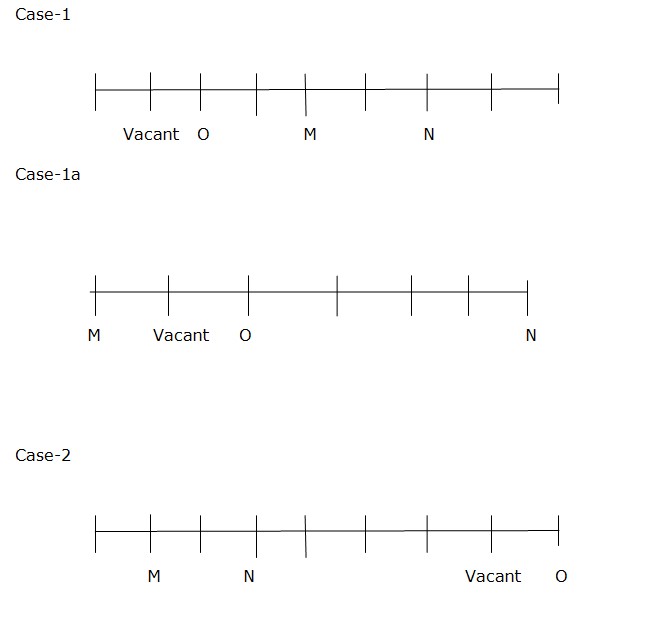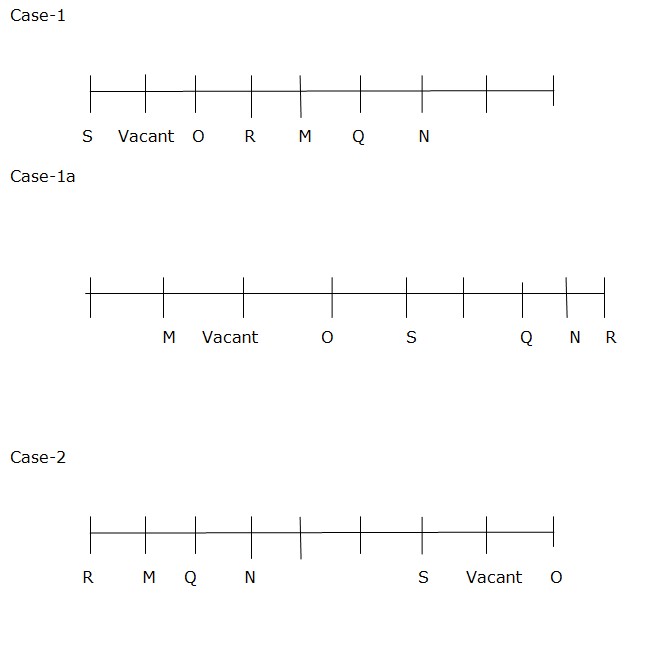Question
Who among the following sits immediate right of Q?
Study the following information carefully and answer the questions given below. Eight friends – M, N, O, P, Q, R, S, and T, are seating on nine seats in a straight line at an equal distance but not necessarily in the same order. One seat in the row is vacant. All of them are facing north directions. There are three persons sit between O and N. The person who sits two places away from N sits fourth to the right of M. M sits neither adjacent to O nor adjacent to S. The person who sits immediate left of the vacant seat sits two places away from O. Q does not sit adjacent to O. R sits two places away from Q. The number of persons who sits between N and R is one less than the number of persons who sits between S and Q. M does not sit at the end. T sits adjacent to N. The number of persons who sits between Q and P is same as the number of persons who sits between T and O. Q does not sit right of N.Solution
There are three persons sit between O and N. The person who sits two places away from N sits fourth to the right of M. M sits neither adjacent to O nor adjacent to S. The person who sits immediate left of the vacant seat sits two places away from O.  Q does not sit adjacent to O. R sits two places away from Q. The number of persons who sits between N and R is one less than the number of persons who sits between S and Q. M does not sit at the end. Q does not sits right of N.
Q does not sit adjacent to O. R sits two places away from Q. The number of persons who sits between N and R is one less than the number of persons who sits between S and Q. M does not sit at the end. Q does not sits right of N.  T sits adjacent to N. This eliminates case 1a. The number of persons who sits between Q and P is same as the number of persons who sits between T and O. This eliminates case 1 and 1a. so final case-2 Case-2
T sits adjacent to N. This eliminates case 1a. The number of persons who sits between Q and P is same as the number of persons who sits between T and O. This eliminates case 1 and 1a. so final case-2 Case-2 
A train crosses a bridge in 15 secs while it crosses a man standing on a platform in 8 secs. If the speed of train 108 km/hrs, then what will be the ti...
- Two stations P and Q are 486 km apart. A train leaves P at 6:45 a.m. at 54 km/h. Another train leaves Q at 8:15 a.m. towards P at 81 km/h. When will they m...
Two trains running at the rates of 108 and 90 kmph respectively, On parallel rails in opposite directions, are observed to pass each other in 24 secon...
'Pritampur' and 'Kanpur' divide by (d - 100) km, while 'Kanpur' and 'Delhi' are distanced by (d + 150) km. Between the stations of Pritampur and Kanpur,...
Train 'E' leaves at 9:00 PM on Wednesday from Kolkata station and reaches Bangalore station at 11:00 AM the next day, while train 'F' leaves at 8:30 PM ...
A train can cross a pole, a bridge of 600 meter long and platform of 480 meter long in 14 seconds, _____ seconds and 30 seconds, respectively.
Th...
Train P travelling at 55 km/hr crosses another train Q, having three fourth of its length and travelling in opposite direction at 35 km/hr in 14 seconds...
Time is taken by two trains running in opposite directions to cross a man standing on the platform in 28 seconds and 16 seconds respectively. It took 24...
Train A running at a speed of 48 km/hr crosses train B in 20 seconds. Find the speed of train B (in km/hr), if the sum of the length of train A and B is...
A train whose speed is 40 m/s crosses a bridge in 20 seconds. Another train which is 80m shorter than the first train crosses the same bridge at the sp...
Relevant for Exams:


